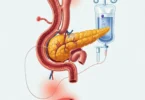Pituitary Tumors
There are many different types of pituitary tumors. What signs and symptoms a tumor causes, depends not only on its size substantially on whether it produces hormones or not and which hormone it forms.
Pituitary: The hormone production determines the symptoms of diseases. Tumors of the pituitary gland (pituitary tumors) are a relatively rare disease. 1-4 people out of 100 000 population are affected per year. [1, 3] Most frequently effect the people between the age of 30 and 45 years. But there are different types of pituitary tumors, where the age of onset can vary greatly. The gender distribution is different in the different pituitary tumors.
pituitary adenomas (about 15% of all brain tumors, peak age 35-45 years) are usually benign tumors that result from outgrowth of cells of the anterior lobe of the pituitary gland, which start producing hormone against the surrounding structures. More than half of adenomas is due to endocrine disruption.
There are many different types of pituitary tumors. This can be explained if you look at structure and function of the pituitary results in mind. The vast majority of pituitary tumors emanates from the anterior pituitary, which corresponds in its construction of a hormone producing gland and therefore known as adenohypophysis. Tumors in this area are accordingly referred as pituitary adenomas.
The main task of the pituitary gland is to make a variety of hormones in their cells that control important metabolic processes in the body organs and regulate the activity of other hormone producing glands. The pituitary cells can multiply and form a tumor, the Pituitary Adenoma. Pituitary adenomas are consider as endocrine tumor (not brain tumor).
Types And Symptoms Of Pituitary Adenomas
In pituitary different hormones are produced, which have important functions in the body. This includes, for. Example, the control of the thyroid and sexual function that are located in a healthy person in a delicate balance. The table gives an overview of the different pituitary tumors.
| Frequency | Type Of Tumor | Made Hormone | Diseases |
| Approximately 50% | Prolactinoma | Prolactin | Menstrual disorders in women, lack of female sex hormone estrogen; in men z. B. sexual dysfunction, decreased beard growth |
| Approximately 21% | Somatotropinom | Growth hormone ( GH = growth hormone or somatotropin) | Acromegaly with magnification of z. B. hands and feet, joint pain, cardiovascular disorders, etc. |
| Approximately 5% | Kortikotropinom | ACTH (Adrenocorticotropic hormone) | Cushing’s syndrome with hyperactivity of the adrenal cortex and z. B. weight gain, hypertension, mental disorders, etc. |
| Approximately 0.4%
|
Thyreotropinom | TSH (thyroid stimulating hormone, thyroid stimulating hormone) | Hyperthyroidism (thyroid gland =) with z. B. palpitations, sweating, diarrhea, weight loss |
| Approximately 23%
|
Hormonal inactive tumors | va symptoms by pressure damage to neighboring tissue, eg. as visual disturbances, headaches, hormone deficiency |
Table. 1: Overview of the different pituitary tumors
Diagnosis
The main diagnostic method is the magnetic resonance imaging (MRI) of the sella region. In order to better assess the bony structures, a computed tomography (CT) may be required. Except for small tumors (Microadenomas) an ophthalmological examination including visual field must be used. Likewise, an endocrinological diagnosis is necessary to determine hormone overproduction and / or failures. In hormonally secured central Cushing’s syndrome if there is no evidence of tumor on MRI, a blood sample from the venous sinuses is recommended with a hormone stimulation test.
Treatments
The surgery is the first line treatment. When we deals with prolactinomas, medications (Eg Dostinex, Norprolac dopamine agonists) are primarily used. For small prolactinomas, the indication for surgery can be checked. In 95%, the operation is carried out via a nose or sinuses, the remaining tumors are powered by a craniotomy. In patients with hormonally active adenomas (acromegaly) may be pretreated with somatostatin analogues (eg Sandostatin LAR). These drugs are also used in non-radical surgery until the onset of radiotherapy effect. When therapy fails, than the growth hormone receptor antagonist Pegvisomant ( Trade name SOMAVERT) is used. Treatment continued with cortisol synthesis inhibitors in elevated levels of cortisol in ACTH-active tumors (Cushing’s syndrome) which promises little success.






